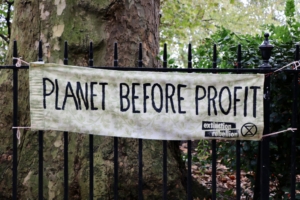Is UBI DOA, an “Arm” up on the Competition, and the Last Straw
Here’s What You Need To Know
Last week, the Finnish government decided not to continue funding its well-publicized trial of a universal basic income (UBI), opting instead to explore other avenues to experiment with welfare policies tailored to meet the needs of the increasingly fluid, dynamic 21st century economy. UBI has long been heralded as the policy answer to automation, and Finland’s experiment was thought to be the catalyst to demonstrate how such a program could really work. In today’s era of disruption, the future of work and its potential policies deserve more attention in the public debate because change is a constant, but it is now happening quicker. So, what does Finland’s delve into UBI mean for the future of work, and how can policymakers in the U.S. learn from it?
- The Details Of Finland’s UBI Experiment: Since January 2017, a random sample of 2,000 unemployed people between the ages of 25 to 58 have been receiving a monthly payment of 560 euros through Finland’s two-year pilot program. This income replaces any existing social benefits, and the recipient continues to receive the monthly income even if they find work. The program is the largest state-sponsored UBI experiment to date, and one of its principal aims – in addition to alleviating poverty and compensating for jobs threatened by automation – is to reduce bureaucracy and test whether UBI is a more flexible policy for providing assistance and work incentives than existing welfare programs.
- The Experiment’s Shortcomings: Finland’s experiment is being run by Kela, the country’s national welfare body, and although the hope was for it to gather new insights into logistics and consequences of a UBI system, poor planning has led to a small sample size that is not scientifically viable. In addition, the design of the experiment is flawed in that it only gives monthly income to unemployed persons rather than a universal income to everyone, and was further hindered at the time of implementation by a conservative government in power that was promoting economic austerity in the midst of economic hardship – hardly the ideal time to, as co-directors at a Finnish economic think tank wrote, “spearhead a leftist benefits program.” Olli Kangas helped design the experiment and is now running it for Kela, a process that in practice he labeled a “nightmare.” Given the experiment’s flaws and the difficulty in implementing it in a rich country with high levels of social spending, the final results should be viewed skeptically and serve as a cautionary tale on the challenges of a UBI system.
- What Do UBI Experiments Look Like In The U.S.? Wired Ideas contributor Joi Ito considers UBI “a partisan issue that, paradoxically, has bipartisan support.” When it comes to UBI, views do not fall along traditional partisan lines, with those voicing support ranging from Milton Friedman and Charles Murray to Martin Luther King, Jr. and Bernie Sanders, and strange bedfellows like Joe Biden and Ben Sasse united in opposition. This range is largely because a UBI system can mean different things to different people, and actual policies can vary as to its theoretical implementation. Some current developments in the U.S. on this front include an experiment in Stockton, California where 100 families receive $500 a month for 18 months, funded through a grant from an organization started by Facebook co-founder Chris Hughes; legislation passed in Hawaii that explores making UBI a reality in that state; and a declared presidential candidate who is running solely on the issue of UBI.
- Alternatives To UBI Going Forward: Finland’s experiment demonstrates the challenges of a UBI system, not least of which is the impact that a government check would have on the value of work and society at large. Even then, that assumes policymakers across the ideological spectrum could agree on what exactly such a policy entails, and garner the support of their constituencies, which seems unlikely. Policies focused on adaptability and continuous education, rather than an “inverted form of feudalism,” could instead provide a better way forward. Instead of more universal models, a cautious approach to “end of work” schemes – which recognizes the futility of predicting the future – may better serve the policy debate, as “a private economy is far more dynamic than the straight line projections … futurists can grasp.”
The largest state-sponsored UBI experiment appears to be dead-on-arrival, but the debate surrounding the future of work continues. As policymakers present solutions for technological disruption, whether a future valued on work over a government check, direct government intervention, the human capital side of the equation, or something else, Finland’s experiment serves as a cautionary tale for policymakers developing ideas for the 21st century economy.
News You Can Use
AN “ARM” UP ON THE COMPETITION
Subscribe to Receive Insights
"*" indicates required fields
Venture capital may not be the first thing that comes to mind when thinking about your airline of choice, yet since 2016, JetBlue Technology Ventures (JTV) has been incubating, investing in, and partnering with “early stage startups at the intersection of technology and travel.” The Silicon Valley-based venture arm of the airline is a first-of-its-kind in its industry, aimed at “driving innovation in the travel and hospitality industries, [making] the airline some money, and [getting] it a seat at the table as some of the most exciting technologies come down the pike.”
Should infusing venture capital into its operations provide JetBlue with a competitive advantage such as that enjoyed by Southwest Airlines in the first decade of this century, when the latter famously loaded up on hedges against higher fuel prices, and which became a common practice among its competitors, in-house investment arms may become as common for airlines as lounges, credit cards, and phone apps.
THE WAR ON STRAWS
Sunday was Earth Day, and the Chicago White Sox’s Guaranteed Rate Field celebrated by becoming the first Major League Baseball stadium at which customers will not automatically receive plastic straws in their drinks, and they will receive a biodegradable straw only upon request. This change comes on the heels of a meeting of the Commonwealth Heads of Government in London, where a proposal to do-away with single-use plastics was introduced, and U.K. Prime Minister Theresa May declared that “plastic waste is one of the greatest environmental challenges facing the world.”
Yet the facts of straw use being cited are nonsense, and the similar bans on single-use plastic bags may actually have the opposite impact intended on the environment. This reality has not dissuaded policymakers, though, who continue to forge ahead. Should interests seek to slow or disrupt these efforts, a public affairs strategy focused on sharing the facts with the public may be the most effective way to move the needle in the debate.
‘TIS THE SEASON FOR SHAREHOLDER ACTIVISM
The season of annual corporate meetings is upon us, and companies are facing political and reputational challenges from both investor and professionalized activism. Recent guidance issued by the Securities and Exchange Commission may play a role in helping companies avoid putting proposals pertaining to everything from “greenhouse gas emissions to discrimination to wasteful K-Cups” on shareholder proxy ballots, but in the public debate, traditional public affairs and reputation management efforts are no longer enough to ensure these meetings, and the rest of a company’s corporate strategy, can be implemented in today’s Age of Activism.
Rather than “hire more lawyers or create more brochure-ware,” Managing Director at BSR and Adjunct Professor at Fordham Law Alison Taylor suggests the best reaction to this new environment is “to equip the corporate fortress with stronger bridges and moats,” a process that can in part be achieved through a competitive intelligence effort that wholly understands the makeup and motivations of an issue’s stakeholders.
CALL ME BIG PASTA
Carb-lovers were rejoicing earlier this month when Newsweek shared a study suggesting that eating pasta was linked to weight loss. But a follow-up report by Buzzfeed discovered that Newsweek “and many other stories failed to note … that three of the scientists behind the study in question had financial conflicts … including ties to the world’s largest pasta company, the Barilla Group,” and listed “Big Pasta’s” ties to scientific conferences, academic studies, and even think tanks.
At Delve, we help our clients gain an information advantage so that they can understand their own vulnerabilities and the network of influence opposing them in the public arena, and both Big Pasta and Buzzfeed hit speed bumps on this front. The former should have anticipated this information becoming public and proactively prepared to push back. As for the latter, Buzzfeed should have been aware that it is difficult to have their critique taken seriously when they have aided and abetted similar efforts in the past, and have come under fire for how advertisers have influenced their editorial content in several noted controversies.



